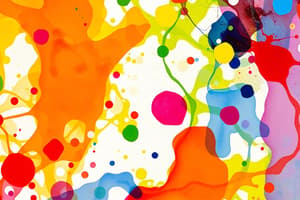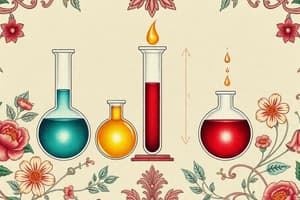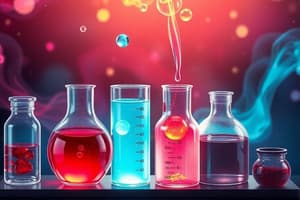Podcast
Questions and Answers
Which of the following statements accurately differentiates between acids and bases?
Which of the following statements accurately differentiates between acids and bases?
- Acids have a pH between 7-14 and produce H+ ions, while bases have a pH between 0-7 and produce OH- ions.
- Acids have a pH greater than 7 and produce OH- ions, while bases have a pH less than 7 and produce H+ ions.
- Acids are bitter and turn red litmus paper blue, while bases are sour and turn blue litmus paper red.
- Acids are sour and turn blue litmus paper red, while bases are bitter and turn red litmus paper blue. (correct)
Onion and clove are considered olfactory indicators because they retain their smell in the presence of a base and lose their smell in the presence of an acid.
Onion and clove are considered olfactory indicators because they retain their smell in the presence of a base and lose their smell in the presence of an acid.
False (B)
A solution turns red litmus paper blue. Is the solution acidic or basic?
A solution turns red litmus paper blue. Is the solution acidic or basic?
basic
The acid present in vinegar is called ______ acid.
The acid present in vinegar is called ______ acid.
Match the following fruits or organs with the acid they contain:
Match the following fruits or organs with the acid they contain:
When equal lengths of magnesium (Mg) ribbon react separately with hydrochloric acid (HCl) and acetic acid (CH3COOH) of the same concentration, which reaction will produce fizzing more vigorously?
When equal lengths of magnesium (Mg) ribbon react separately with hydrochloric acid (HCl) and acetic acid (CH3COOH) of the same concentration, which reaction will produce fizzing more vigorously?
If a knife used to cut a fruit is dipped into water containing blue litmus solution and the solution turns red, what can you infer about the fruit?
If a knife used to cut a fruit is dipped into water containing blue litmus solution and the solution turns red, what can you infer about the fruit?
Two solutions, P and Q, are tested with a universal indicator. Solution P turns red, while solution Q turns orange. Which of the following statements is correct?
Two solutions, P and Q, are tested with a universal indicator. Solution P turns red, while solution Q turns orange. Which of the following statements is correct?
Flashcards
Acids
Acids
Taste sour, turn blue litmus red, produce H+ ions, pH 0-7.
Bases
Bases
Taste bitter, turn red litmus blue, produce OH- ions, pH 7-14.
Natural indicators
Natural indicators
Litmus, turmeric, purple cabbage
Litmus with sodium hydrogen carbonate
Litmus with sodium hydrogen carbonate
Signup and view all the flashcards
Olfactory indicator
Olfactory indicator
Signup and view all the flashcards
Acids
Acids
Signup and view all the flashcards
HCl vs. CH3COOH
HCl vs. CH3COOH
Signup and view all the flashcards
Basic solution
Basic solution
Signup and view all the flashcards
Study Notes
- Acids taste sour, turn blue litmus paper red, produce H+ ions, and have pH values between 0 and 7.
- Bases are characterized with a pH between 7 and 14, exemplified by sodium hydroxide.
Natural Indicators
- Litmus, turmeric, and purple cabbage are examples of natural indicators.
Litmus Color in Sodium Hydrogen Carbonate
- Litmus will turn blue in a solution of sodium hydrogen carbonate, because it is basic.
Acidity and pH of Solutions P and Q
- Solution P, turning red with a universal indicator, is more acidic.
- Solution Q, turning orange, has a higher pH value compared to Solution P.
Olfactory Indicators
- Onion and clove are olfactory indicators because they lose their smell in the presence of a base but retain it in the presence of an acid.
Identifying Solutions with Red Litmus Paper
- Red litmus paper turns blue in a basic solution.
- Blue litmus paper (obtained from the basic solution test) turns red in an acidic solution.
- If the litmus paper's color does not change, the solution is distilled water.
Fruit Acidity
- If blue litmus solution turns red when a knife used to cut a fruit is dipped into it, the fruit is acidic.
- Acids turn blue litmus into red.
Acids Present in Substances
- Tomato contains oxalic acid.
- Vinegar contains acetic acid.
- Tamarind contains tartaric acid.
- Lemon contains citric acid.
- Stomach contains hydrochloric acid.
Reaction of Mg Ribbons with Acids
- Fizzing occurs more vigorously in test tube A, which contains hydrochloric acid (HCl).
- HCl is a stronger acid than acetic acid (CH3COOH) and produces hydrogen gas faster, causing more fizzing.
Reaction of Sodium Salt with Hydrochloric Acid
- The gas produced during the chemical reaction is carbon dioxide.
- The colorless solution is lime water/calcium hydroxide [Ca(OH)2].
- It turns milky due to the formation of a white precipitate, CaCO3.
Studying That Suits You
Use AI to generate personalized quizzes and flashcards to suit your learning preferences.



